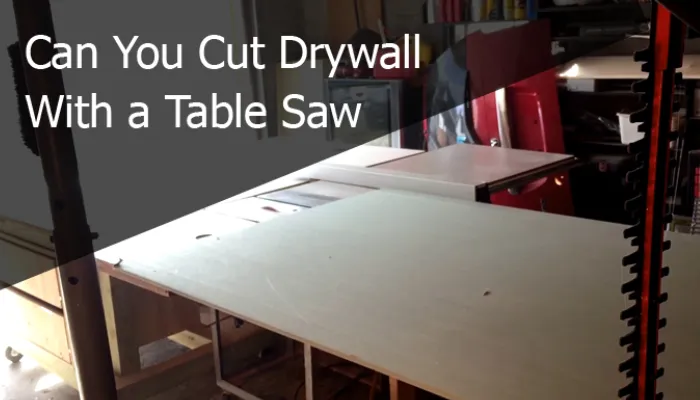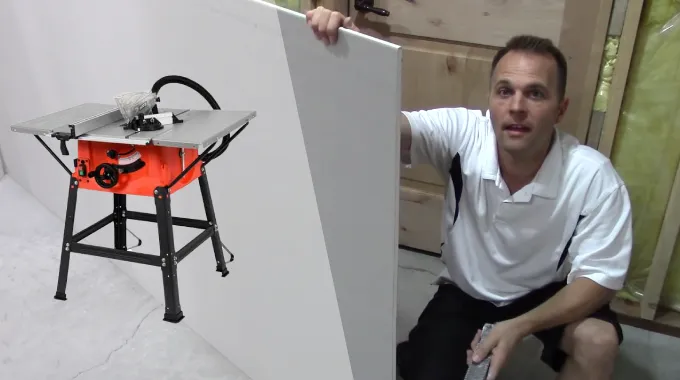Can you cut drywall with a table saw? It’s a common question among DIY enthusiasts, and today we’re here to shed some light on the topic. So grab your safety goggles and let’s dive in!
Now, before we get into the nitty-gritty, let me tell you why this question is worth exploring. Cutting drywall can be a tricky task, and using the right tools is crucial to achieve a clean and precise cut. But can a table saw do the job? That’s what we’re here to find out.
In this article, we’ll discuss the ins and outs of cutting drywall with a table saw. We’ll explore the benefits and risks, share some tips and tricks, and even address alternative methods. So if you’re ready to become a drywall-cutting pro, keep on reading!
Table saws can be used to cut drywall, but it’s not the most recommended option. Drywall is easily damaged by the high speed and spinning blade of a table saw. It’s better to use a utility knife or a drywall saw, which give you more control and reduce the risk of accidents. Additionally, using a specialized tool like a drywall router can provide clean and precise cuts in drywall. Always prioritize safety and choose the right tool for the job!

Can You Cut Drywall with a Table Saw?
Drywall is a common material used in construction and home improvement projects. It is used to create interior walls and ceilings, providing a smooth and even surface for finishing. When it comes to cutting drywall, there are various tools that can be used, including a table saw. In this article, we will explore the possibility of cutting drywall with a table saw and discuss the benefits, precautions, and tips to consider.
1. Understanding the Possibility of Cutting Drywall with a Table Saw
Cutting drywall with a table saw is technically possible, as the saw’s sharp blade can easily slice through the material. However, it is important to note that using a table saw for this purpose requires caution and proper technique. Table saws are typically designed for cutting larger and denser materials, such as wood, and may not be optimized for cutting drywall.
One of the main challenges of using a table saw for cutting drywall is controlling the material as it passes through the blade. Drywall is a lightweight and flexible material, and without proper support and guidance, it can easily crack or break during the cutting process. Additionally, the dust and debris generated when cutting drywall can pose a health risk if not properly managed.
To safely and effectively cut drywall with a table saw, it is important to make certain modifications and use appropriate accessories. These may include a zero-clearance insert to prevent the material from getting caught in the blade, a dust collection system to minimize airborne particles, and a guide or fence to ensure straight and accurate cuts.
2. Benefits of Cutting Drywall with a Table Saw
Despite the challenges and precautions involved, there are some benefits to cutting drywall with a table saw. First and foremost, using a table saw allows for precise and consistent cuts. This is especially important when working on larger projects where multiple sheets of drywall need to be cut to the same dimensions. The table saw’s adjustable fence and precise blade control can help achieve accurate measurements and reduce the need for additional trimming or adjustments.
Another advantage of using a table saw for cutting drywall is the ability to achieve clean and smooth edges. This can be particularly useful when installing drywall in areas that require tight seams or when applying finishing materials that require flush and seamless transitions. A well-maintained table saw blade can produce clean cuts that minimize the need for extensive sanding or patching.
Furthermore, for individuals who already own a table saw in their workshop, utilizing the tool for cutting drywall can save time and money. Instead of purchasing or renting specialized drywall cutting tools, such as rotary tools or drywall saws, homeowners and contractors can utilize their existing table saw to perform the task. This can be particularly beneficial for individuals who frequently work with drywall or engage in various home improvement projects.
3. Precautions and Tips for Cutting Drywall with a Table Saw
While cutting drywall with a table saw can be beneficial, it is crucial to follow necessary precautions and employ proper techniques to ensure safety and optimal results. Here are some important considerations to keep in mind:
1. Safety should always be the top priority. Before cutting drywall, ensure that you are wearing appropriate safety gear, including safety glasses, ear protection, and a dust mask.
2. Make sure to use a sharp and clean blade specifically designed for cutting drywall. A dull blade can cause more damage to the material and result in rough edges.
3. Set up the table saw properly before cutting. Consider using a zero-clearance insert and a fence or guide that is perpendicular to the blade to maintain accuracy and prevent kickback.
4. Securely support the drywall throughout the cutting process to prevent flexing. This can be achieved by using infeed and outfeed support or a dedicated stand designed for cutting drywall with a table saw.
5. To minimize dust and airborne particles, connect a dust collection system to the table saw. This will help maintain a cleaner and healthier work environment.
6. Plan the cutting process in advance and mark the desired cut lines on the drywall. Take measurements accurately and double-check before making any cuts.
7. Take your time and move the drywall steadily through the blade. Avoid forcing the material through or rushing the process, as this can lead to inaccurate cuts or accidents.
8. After cutting, inspect the resulting edges for any potential damage or roughness. If necessary, use a rasp or sandpaper to smooth out any imperfections.
In conclusion, while it is technically possible to cut drywall with a table saw, it requires careful consideration and adherence to safety guidelines. The benefits of using a table saw for cutting drywall include precise cuts, smooth edges, and potentially saving time and money. However, it is important to take necessary precautions, such as employing proper accessories, supporting the material adequately, and using appropriate safety gear. By following these guidelines, individuals can effectively and safely cut drywall with a table saw, achieving professional results in their construction projects.
Key Takeaways: Can You Cut Drywall with a Table Saw?
- Yes, you can cut drywall with a table saw.
- Make sure to use the appropriate blade for cutting drywall.
- Take safety precautions, such as wearing protective eyewear and a dust mask.
- Measure and mark the cut lines on the drywall before cutting.
- Feed the drywall into the table saw slowly and steadily for a clean cut.
Frequently Asked Questions
Are you wondering if a table saw can be used to cut drywall? Check out the answers to common questions below!
1. Is it safe to cut drywall with a table saw?
Yes, it is safe to cut drywall with a table saw if you take the necessary precautions. Make sure you are using the right blade for cutting drywall, which is usually a carbide-tipped or diamond-tipped blade. Additionally, wear safety goggles to protect your eyes from dust and debris, and always keep your hands away from the blade.
It’s also important to secure the drywall properly before cutting. Use clamps or a dedicated cutting guide to keep the drywall steady and prevent it from moving while you cut. By following safety guidelines and using the appropriate equipment, you can safely cut drywall with a table saw.
2. Can I use a regular table saw blade to cut drywall?
While it is possible to use a regular table saw blade to cut drywall, it is not recommended. Regular blades are typically designed for cutting wood and may cause the drywall to splinter, resulting in rough edges. Using the wrong blade can also damage the saw or make the cutting process more difficult.
It is best to use a blade specifically designed for cutting drywall. These blades have special teeth that minimize the chance of splintering and create clean, precise cuts. Investing in the right blade will save you time and effort while ensuring a professional-looking finish on your drywall.
3. Do I need any special accessories to cut drywall with a table saw?
While not required, there are a few accessories that can make cutting drywall with a table saw easier and more efficient. One such accessory is a drywall cutting guide. This guide helps keep the drywall straight and prevents it from shifting during the cutting process, resulting in cleaner cuts.
Another helpful accessory is a dust collection system. Drywall can create a lot of dust when cut, which can be harmful to breathe in and make a mess in your workspace. A dust collection system helps capture the dust, keeping the air clean and your workspace tidy.
4. Can I use a circular saw instead of a table saw to cut drywall?
Yes, you can absolutely use a circular saw to cut drywall. Circular saws are commonly used for this purpose and can produce clean and accurate cuts. Just like with a table saw, it’s important to use the right blade for cutting drywall and take the necessary safety precautions.
When using a circular saw, make sure you have a straight edge or guide to follow for precise cuts. Clamping the straight edge to the drywall can help keep the saw on track as you cut. Always wear safety goggles and keep your hands away from the blade to prevent accidents.
5. What are some tips for cutting drywall with a table saw?
Here are a few tips to make cutting drywall with a table saw easier and more efficient:
– Measure and mark the cut line carefully before starting to ensure accuracy.
– Cut with the finished side of the drywall facing up to minimize splintering.
– Use a slow and steady feed rate to maintain control and prevent kickback.
– Make sure the table saw is set up and properly adjusted for the thickness of the drywall.
Following these tips will help you achieve clean, precise cuts when using a table saw to cut drywall.

Summary
You cannot cut drywall with a table saw because it can damage the material and create a mess. Instead, use a drywall saw or utility knife to make precise and smooth cuts. Remember to measure and mark your cuts accurately before starting.
Additionally, it’s important to wear safety goggles and a dust mask to protect your eyes and lungs from dust and debris. Make sure to work in a well-ventilated area and clean up any dust or debris after you’re done. Cutting drywall can be easy and safe when using the right tools and taking proper precautions.
